Importance of Radiography: A Clinical Reasoning Cycle Assessment
VerifiedAdded on 2022/12/14
|11
|3091
|379
Report
AI Summary
This report examines the importance of radiography in healthcare through a clinical reasoning cycle assessment of a 56-year-old patient, Mrs. Kennedy, admitted with pneumonia. The report details the collection of subjective and objective data, including vital signs, and links these findings to the patient's pathophysiological processes, such as coronary heart disease and hypertension. It prioritizes care for chest pain, upper arm pain, and nausea, offering relevant interventions. The assignment also incorporates psychological factors, like economic concerns and loneliness, impacting the patient's mental and physical health. The conclusion emphasizes the effectiveness of the clinical reasoning cycle in analyzing patient conditions and highlights the need for comprehensive mental and physical nursing care for Mrs. Kennedy's recovery.
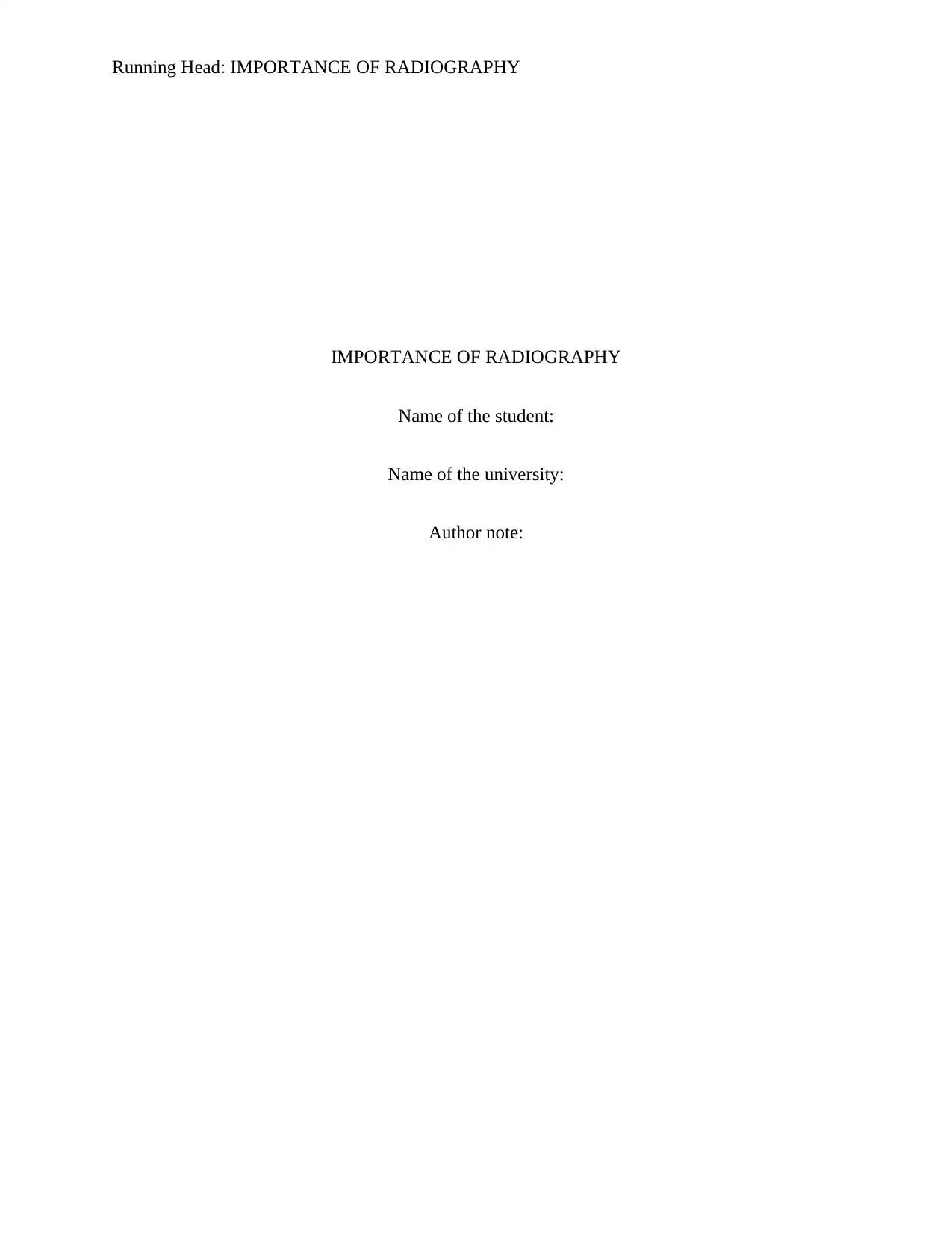
Running Head: IMPORTANCE OF RADIOGRAPHY
IMPORTANCE OF RADIOGRAPHY
Name of the student:
Name of the university:
Author note:
IMPORTANCE OF RADIOGRAPHY
Name of the student:
Name of the university:
Author note:
Paraphrase This Document
Need a fresh take? Get an instant paraphrase of this document with our AI Paraphraser
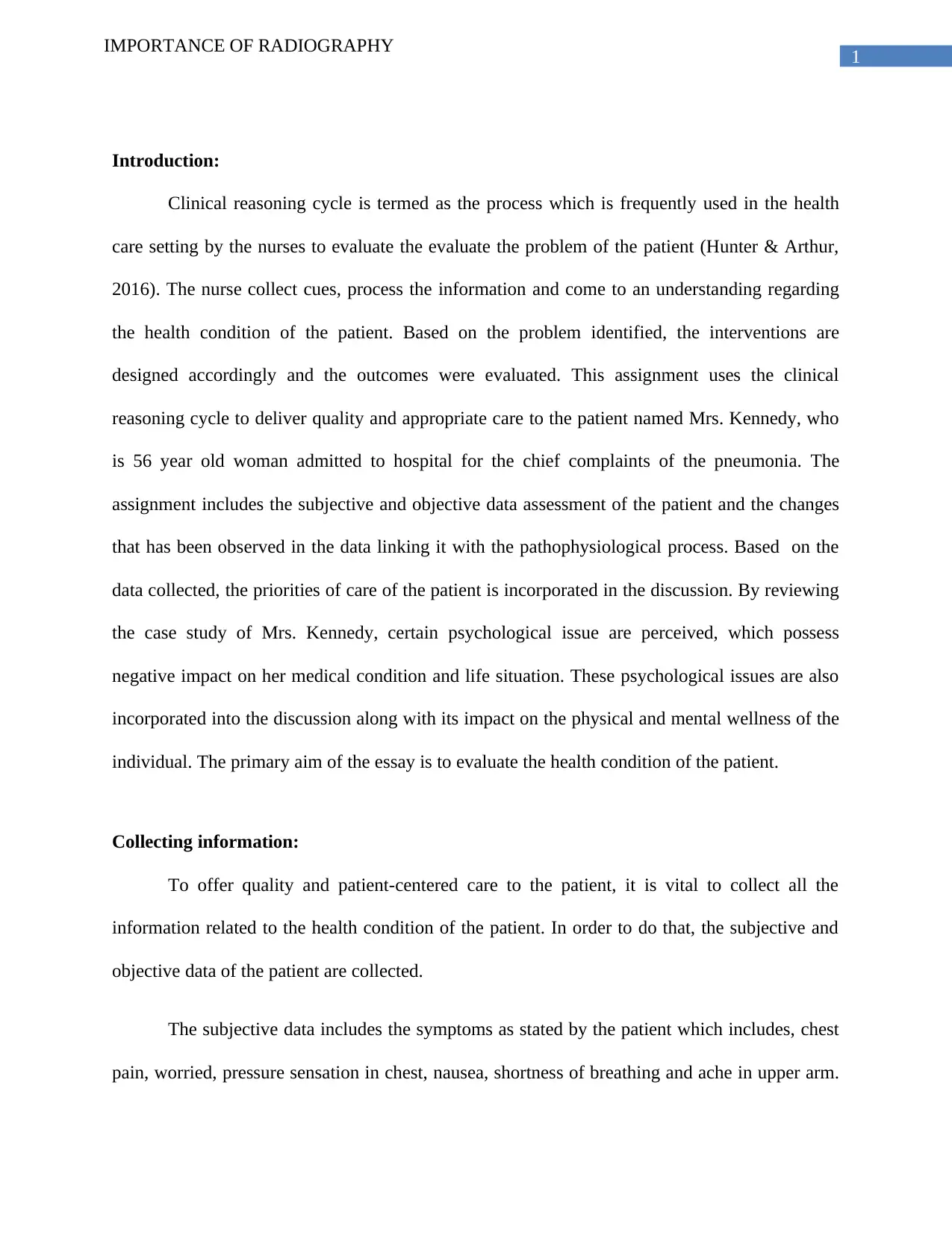
1
IMPORTANCE OF RADIOGRAPHY
Introduction:
Clinical reasoning cycle is termed as the process which is frequently used in the health
care setting by the nurses to evaluate the evaluate the problem of the patient (Hunter & Arthur,
2016). The nurse collect cues, process the information and come to an understanding regarding
the health condition of the patient. Based on the problem identified, the interventions are
designed accordingly and the outcomes were evaluated. This assignment uses the clinical
reasoning cycle to deliver quality and appropriate care to the patient named Mrs. Kennedy, who
is 56 year old woman admitted to hospital for the chief complaints of the pneumonia. The
assignment includes the subjective and objective data assessment of the patient and the changes
that has been observed in the data linking it with the pathophysiological process. Based on the
data collected, the priorities of care of the patient is incorporated in the discussion. By reviewing
the case study of Mrs. Kennedy, certain psychological issue are perceived, which possess
negative impact on her medical condition and life situation. These psychological issues are also
incorporated into the discussion along with its impact on the physical and mental wellness of the
individual. The primary aim of the essay is to evaluate the health condition of the patient.
Collecting information:
To offer quality and patient-centered care to the patient, it is vital to collect all the
information related to the health condition of the patient. In order to do that, the subjective and
objective data of the patient are collected.
The subjective data includes the symptoms as stated by the patient which includes, chest
pain, worried, pressure sensation in chest, nausea, shortness of breathing and ache in upper arm.
IMPORTANCE OF RADIOGRAPHY
Introduction:
Clinical reasoning cycle is termed as the process which is frequently used in the health
care setting by the nurses to evaluate the evaluate the problem of the patient (Hunter & Arthur,
2016). The nurse collect cues, process the information and come to an understanding regarding
the health condition of the patient. Based on the problem identified, the interventions are
designed accordingly and the outcomes were evaluated. This assignment uses the clinical
reasoning cycle to deliver quality and appropriate care to the patient named Mrs. Kennedy, who
is 56 year old woman admitted to hospital for the chief complaints of the pneumonia. The
assignment includes the subjective and objective data assessment of the patient and the changes
that has been observed in the data linking it with the pathophysiological process. Based on the
data collected, the priorities of care of the patient is incorporated in the discussion. By reviewing
the case study of Mrs. Kennedy, certain psychological issue are perceived, which possess
negative impact on her medical condition and life situation. These psychological issues are also
incorporated into the discussion along with its impact on the physical and mental wellness of the
individual. The primary aim of the essay is to evaluate the health condition of the patient.
Collecting information:
To offer quality and patient-centered care to the patient, it is vital to collect all the
information related to the health condition of the patient. In order to do that, the subjective and
objective data of the patient are collected.
The subjective data includes the symptoms as stated by the patient which includes, chest
pain, worried, pressure sensation in chest, nausea, shortness of breathing and ache in upper arm.
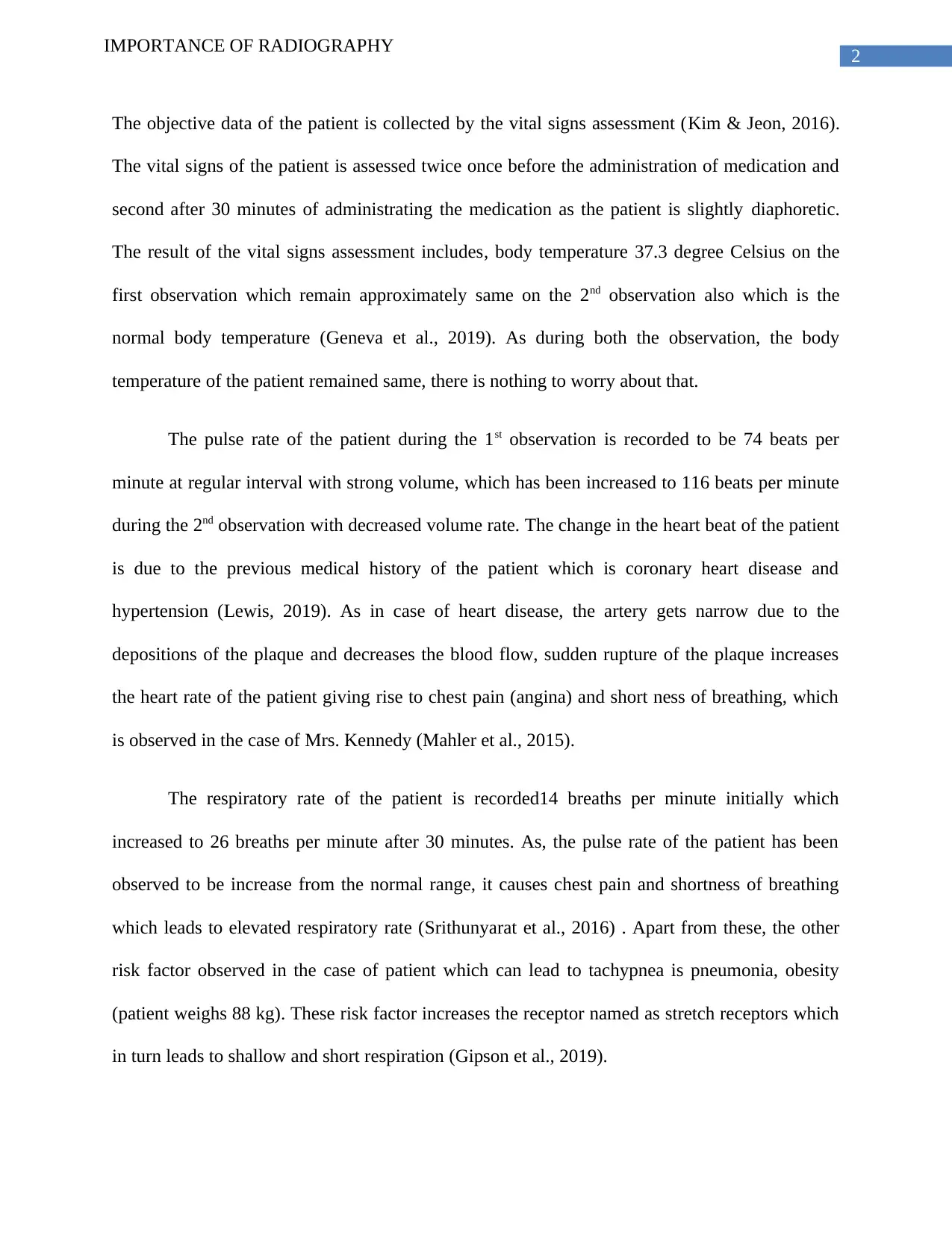
2
IMPORTANCE OF RADIOGRAPHY
The objective data of the patient is collected by the vital signs assessment (Kim & Jeon, 2016).
The vital signs of the patient is assessed twice once before the administration of medication and
second after 30 minutes of administrating the medication as the patient is slightly diaphoretic.
The result of the vital signs assessment includes, body temperature 37.3 degree Celsius on the
first observation which remain approximately same on the 2nd observation also which is the
normal body temperature (Geneva et al., 2019). As during both the observation, the body
temperature of the patient remained same, there is nothing to worry about that.
The pulse rate of the patient during the 1st observation is recorded to be 74 beats per
minute at regular interval with strong volume, which has been increased to 116 beats per minute
during the 2nd observation with decreased volume rate. The change in the heart beat of the patient
is due to the previous medical history of the patient which is coronary heart disease and
hypertension (Lewis, 2019). As in case of heart disease, the artery gets narrow due to the
depositions of the plaque and decreases the blood flow, sudden rupture of the plaque increases
the heart rate of the patient giving rise to chest pain (angina) and short ness of breathing, which
is observed in the case of Mrs. Kennedy (Mahler et al., 2015).
The respiratory rate of the patient is recorded14 breaths per minute initially which
increased to 26 breaths per minute after 30 minutes. As, the pulse rate of the patient has been
observed to be increase from the normal range, it causes chest pain and shortness of breathing
which leads to elevated respiratory rate (Srithunyarat et al., 2016) . Apart from these, the other
risk factor observed in the case of patient which can lead to tachypnea is pneumonia, obesity
(patient weighs 88 kg). These risk factor increases the receptor named as stretch receptors which
in turn leads to shallow and short respiration (Gipson et al., 2019).
IMPORTANCE OF RADIOGRAPHY
The objective data of the patient is collected by the vital signs assessment (Kim & Jeon, 2016).
The vital signs of the patient is assessed twice once before the administration of medication and
second after 30 minutes of administrating the medication as the patient is slightly diaphoretic.
The result of the vital signs assessment includes, body temperature 37.3 degree Celsius on the
first observation which remain approximately same on the 2nd observation also which is the
normal body temperature (Geneva et al., 2019). As during both the observation, the body
temperature of the patient remained same, there is nothing to worry about that.
The pulse rate of the patient during the 1st observation is recorded to be 74 beats per
minute at regular interval with strong volume, which has been increased to 116 beats per minute
during the 2nd observation with decreased volume rate. The change in the heart beat of the patient
is due to the previous medical history of the patient which is coronary heart disease and
hypertension (Lewis, 2019). As in case of heart disease, the artery gets narrow due to the
depositions of the plaque and decreases the blood flow, sudden rupture of the plaque increases
the heart rate of the patient giving rise to chest pain (angina) and short ness of breathing, which
is observed in the case of Mrs. Kennedy (Mahler et al., 2015).
The respiratory rate of the patient is recorded14 breaths per minute initially which
increased to 26 breaths per minute after 30 minutes. As, the pulse rate of the patient has been
observed to be increase from the normal range, it causes chest pain and shortness of breathing
which leads to elevated respiratory rate (Srithunyarat et al., 2016) . Apart from these, the other
risk factor observed in the case of patient which can lead to tachypnea is pneumonia, obesity
(patient weighs 88 kg). These risk factor increases the receptor named as stretch receptors which
in turn leads to shallow and short respiration (Gipson et al., 2019).
⊘ This is a preview!⊘
Do you want full access?
Subscribe today to unlock all pages.

Trusted by 1+ million students worldwide
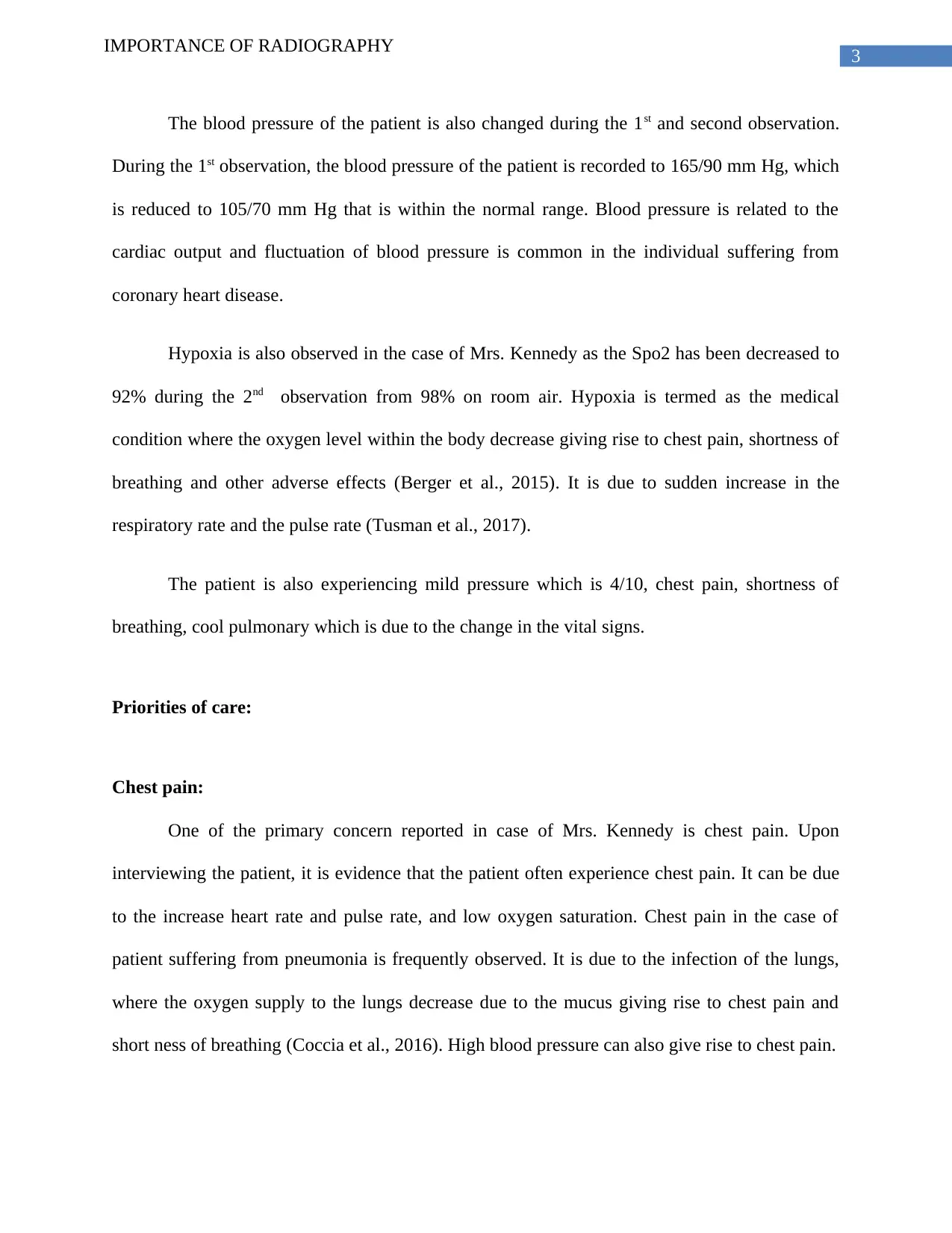
3
IMPORTANCE OF RADIOGRAPHY
The blood pressure of the patient is also changed during the 1st and second observation.
During the 1st observation, the blood pressure of the patient is recorded to 165/90 mm Hg, which
is reduced to 105/70 mm Hg that is within the normal range. Blood pressure is related to the
cardiac output and fluctuation of blood pressure is common in the individual suffering from
coronary heart disease.
Hypoxia is also observed in the case of Mrs. Kennedy as the Spo2 has been decreased to
92% during the 2nd observation from 98% on room air. Hypoxia is termed as the medical
condition where the oxygen level within the body decrease giving rise to chest pain, shortness of
breathing and other adverse effects (Berger et al., 2015). It is due to sudden increase in the
respiratory rate and the pulse rate (Tusman et al., 2017).
The patient is also experiencing mild pressure which is 4/10, chest pain, shortness of
breathing, cool pulmonary which is due to the change in the vital signs.
Priorities of care:
Chest pain:
One of the primary concern reported in case of Mrs. Kennedy is chest pain. Upon
interviewing the patient, it is evidence that the patient often experience chest pain. It can be due
to the increase heart rate and pulse rate, and low oxygen saturation. Chest pain in the case of
patient suffering from pneumonia is frequently observed. It is due to the infection of the lungs,
where the oxygen supply to the lungs decrease due to the mucus giving rise to chest pain and
short ness of breathing (Coccia et al., 2016). High blood pressure can also give rise to chest pain.
IMPORTANCE OF RADIOGRAPHY
The blood pressure of the patient is also changed during the 1st and second observation.
During the 1st observation, the blood pressure of the patient is recorded to 165/90 mm Hg, which
is reduced to 105/70 mm Hg that is within the normal range. Blood pressure is related to the
cardiac output and fluctuation of blood pressure is common in the individual suffering from
coronary heart disease.
Hypoxia is also observed in the case of Mrs. Kennedy as the Spo2 has been decreased to
92% during the 2nd observation from 98% on room air. Hypoxia is termed as the medical
condition where the oxygen level within the body decrease giving rise to chest pain, shortness of
breathing and other adverse effects (Berger et al., 2015). It is due to sudden increase in the
respiratory rate and the pulse rate (Tusman et al., 2017).
The patient is also experiencing mild pressure which is 4/10, chest pain, shortness of
breathing, cool pulmonary which is due to the change in the vital signs.
Priorities of care:
Chest pain:
One of the primary concern reported in case of Mrs. Kennedy is chest pain. Upon
interviewing the patient, it is evidence that the patient often experience chest pain. It can be due
to the increase heart rate and pulse rate, and low oxygen saturation. Chest pain in the case of
patient suffering from pneumonia is frequently observed. It is due to the infection of the lungs,
where the oxygen supply to the lungs decrease due to the mucus giving rise to chest pain and
short ness of breathing (Coccia et al., 2016). High blood pressure can also give rise to chest pain.
Paraphrase This Document
Need a fresh take? Get an instant paraphrase of this document with our AI Paraphraser
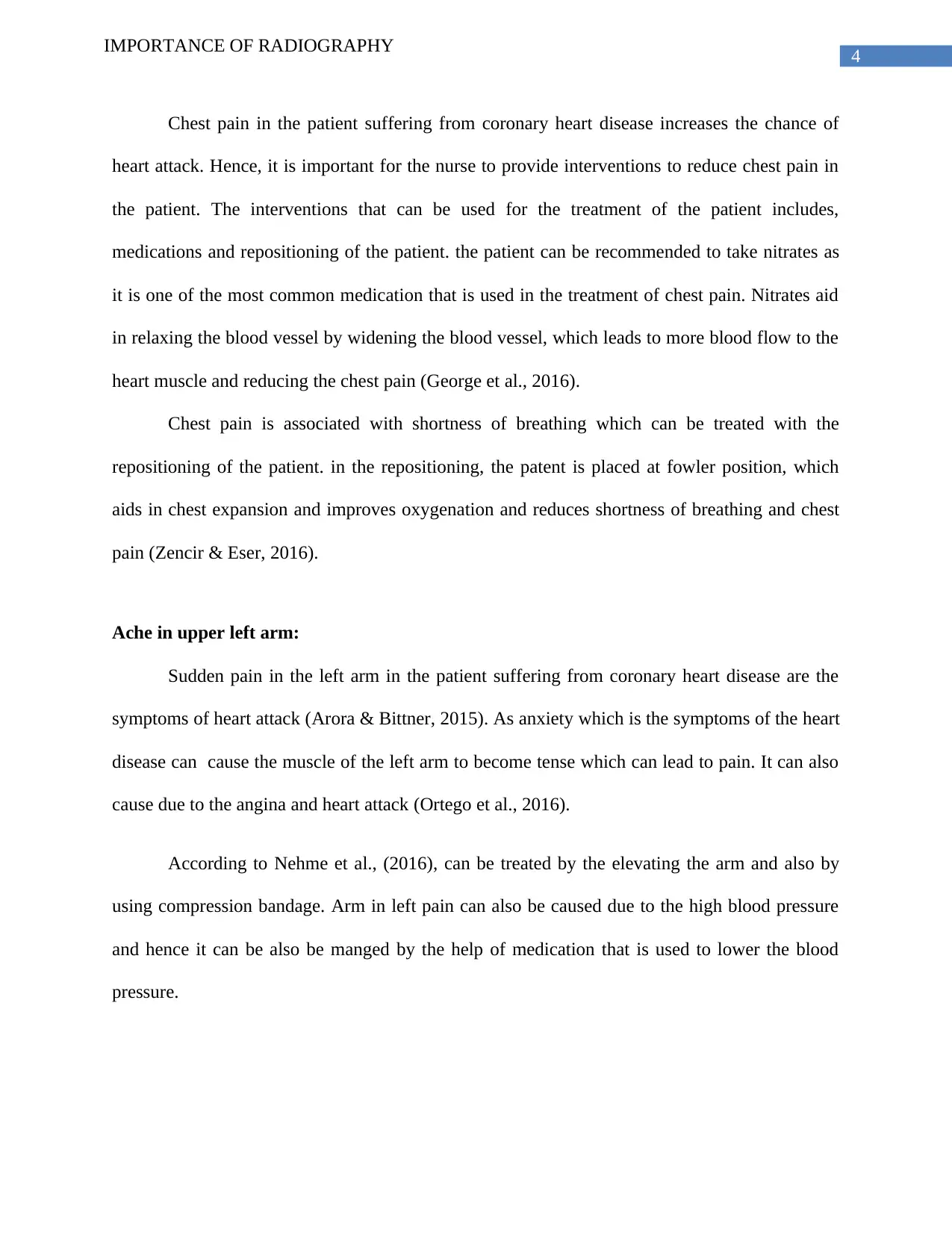
4
IMPORTANCE OF RADIOGRAPHY
Chest pain in the patient suffering from coronary heart disease increases the chance of
heart attack. Hence, it is important for the nurse to provide interventions to reduce chest pain in
the patient. The interventions that can be used for the treatment of the patient includes,
medications and repositioning of the patient. the patient can be recommended to take nitrates as
it is one of the most common medication that is used in the treatment of chest pain. Nitrates aid
in relaxing the blood vessel by widening the blood vessel, which leads to more blood flow to the
heart muscle and reducing the chest pain (George et al., 2016).
Chest pain is associated with shortness of breathing which can be treated with the
repositioning of the patient. in the repositioning, the patent is placed at fowler position, which
aids in chest expansion and improves oxygenation and reduces shortness of breathing and chest
pain (Zencir & Eser, 2016).
Ache in upper left arm:
Sudden pain in the left arm in the patient suffering from coronary heart disease are the
symptoms of heart attack (Arora & Bittner, 2015). As anxiety which is the symptoms of the heart
disease can cause the muscle of the left arm to become tense which can lead to pain. It can also
cause due to the angina and heart attack (Ortego et al., 2016).
According to Nehme et al., (2016), can be treated by the elevating the arm and also by
using compression bandage. Arm in left pain can also be caused due to the high blood pressure
and hence it can be also be manged by the help of medication that is used to lower the blood
pressure.
IMPORTANCE OF RADIOGRAPHY
Chest pain in the patient suffering from coronary heart disease increases the chance of
heart attack. Hence, it is important for the nurse to provide interventions to reduce chest pain in
the patient. The interventions that can be used for the treatment of the patient includes,
medications and repositioning of the patient. the patient can be recommended to take nitrates as
it is one of the most common medication that is used in the treatment of chest pain. Nitrates aid
in relaxing the blood vessel by widening the blood vessel, which leads to more blood flow to the
heart muscle and reducing the chest pain (George et al., 2016).
Chest pain is associated with shortness of breathing which can be treated with the
repositioning of the patient. in the repositioning, the patent is placed at fowler position, which
aids in chest expansion and improves oxygenation and reduces shortness of breathing and chest
pain (Zencir & Eser, 2016).
Ache in upper left arm:
Sudden pain in the left arm in the patient suffering from coronary heart disease are the
symptoms of heart attack (Arora & Bittner, 2015). As anxiety which is the symptoms of the heart
disease can cause the muscle of the left arm to become tense which can lead to pain. It can also
cause due to the angina and heart attack (Ortego et al., 2016).
According to Nehme et al., (2016), can be treated by the elevating the arm and also by
using compression bandage. Arm in left pain can also be caused due to the high blood pressure
and hence it can be also be manged by the help of medication that is used to lower the blood
pressure.
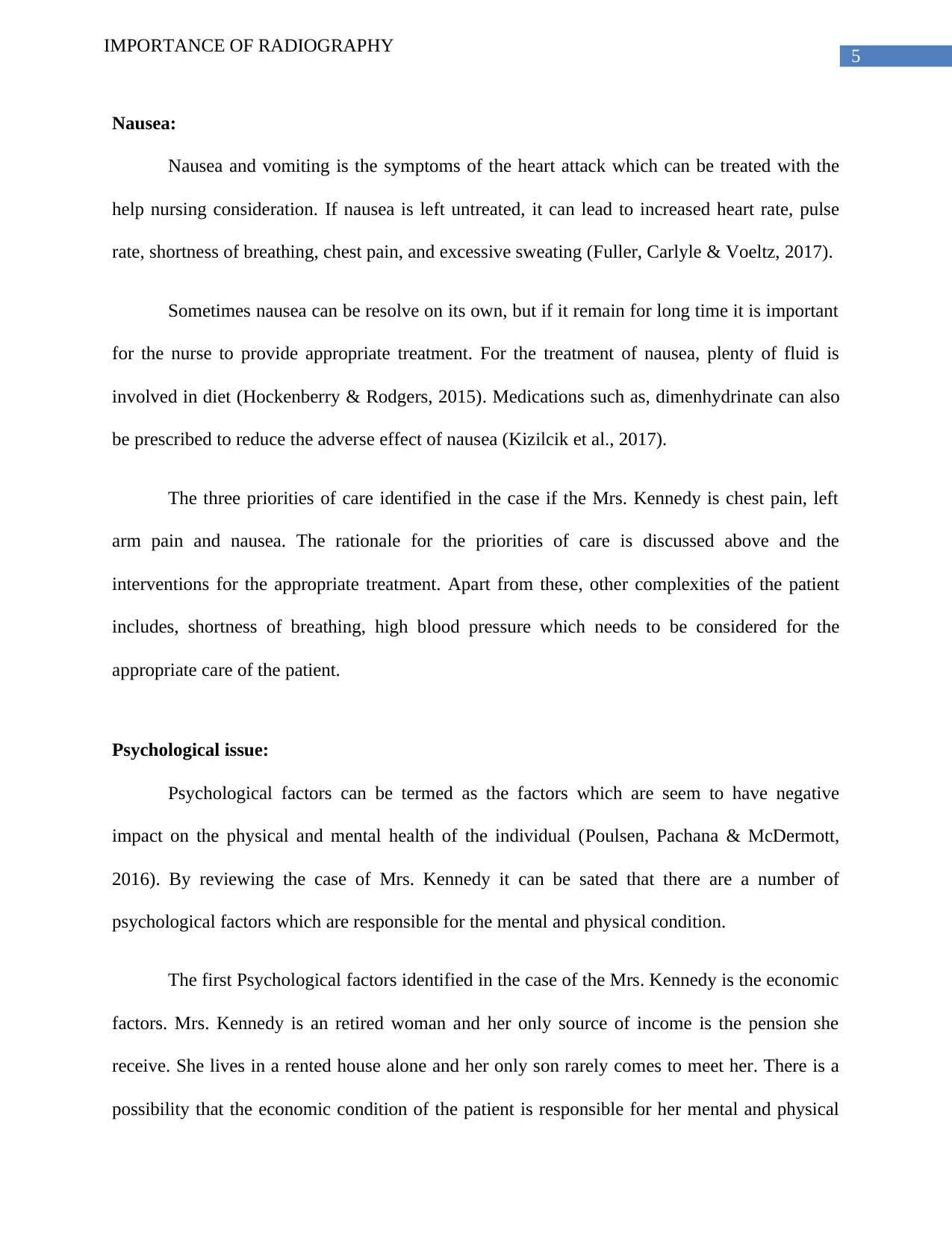
5
IMPORTANCE OF RADIOGRAPHY
Nausea:
Nausea and vomiting is the symptoms of the heart attack which can be treated with the
help nursing consideration. If nausea is left untreated, it can lead to increased heart rate, pulse
rate, shortness of breathing, chest pain, and excessive sweating (Fuller, Carlyle & Voeltz, 2017).
Sometimes nausea can be resolve on its own, but if it remain for long time it is important
for the nurse to provide appropriate treatment. For the treatment of nausea, plenty of fluid is
involved in diet (Hockenberry & Rodgers, 2015). Medications such as, dimenhydrinate can also
be prescribed to reduce the adverse effect of nausea (Kizilcik et al., 2017).
The three priorities of care identified in the case if the Mrs. Kennedy is chest pain, left
arm pain and nausea. The rationale for the priorities of care is discussed above and the
interventions for the appropriate treatment. Apart from these, other complexities of the patient
includes, shortness of breathing, high blood pressure which needs to be considered for the
appropriate care of the patient.
Psychological issue:
Psychological factors can be termed as the factors which are seem to have negative
impact on the physical and mental health of the individual (Poulsen, Pachana & McDermott,
2016). By reviewing the case of Mrs. Kennedy it can be sated that there are a number of
psychological factors which are responsible for the mental and physical condition.
The first Psychological factors identified in the case of the Mrs. Kennedy is the economic
factors. Mrs. Kennedy is an retired woman and her only source of income is the pension she
receive. She lives in a rented house alone and her only son rarely comes to meet her. There is a
possibility that the economic condition of the patient is responsible for her mental and physical
IMPORTANCE OF RADIOGRAPHY
Nausea:
Nausea and vomiting is the symptoms of the heart attack which can be treated with the
help nursing consideration. If nausea is left untreated, it can lead to increased heart rate, pulse
rate, shortness of breathing, chest pain, and excessive sweating (Fuller, Carlyle & Voeltz, 2017).
Sometimes nausea can be resolve on its own, but if it remain for long time it is important
for the nurse to provide appropriate treatment. For the treatment of nausea, plenty of fluid is
involved in diet (Hockenberry & Rodgers, 2015). Medications such as, dimenhydrinate can also
be prescribed to reduce the adverse effect of nausea (Kizilcik et al., 2017).
The three priorities of care identified in the case if the Mrs. Kennedy is chest pain, left
arm pain and nausea. The rationale for the priorities of care is discussed above and the
interventions for the appropriate treatment. Apart from these, other complexities of the patient
includes, shortness of breathing, high blood pressure which needs to be considered for the
appropriate care of the patient.
Psychological issue:
Psychological factors can be termed as the factors which are seem to have negative
impact on the physical and mental health of the individual (Poulsen, Pachana & McDermott,
2016). By reviewing the case of Mrs. Kennedy it can be sated that there are a number of
psychological factors which are responsible for the mental and physical condition.
The first Psychological factors identified in the case of the Mrs. Kennedy is the economic
factors. Mrs. Kennedy is an retired woman and her only source of income is the pension she
receive. She lives in a rented house alone and her only son rarely comes to meet her. There is a
possibility that the economic condition of the patient is responsible for her mental and physical
⊘ This is a preview!⊘
Do you want full access?
Subscribe today to unlock all pages.

Trusted by 1+ million students worldwide
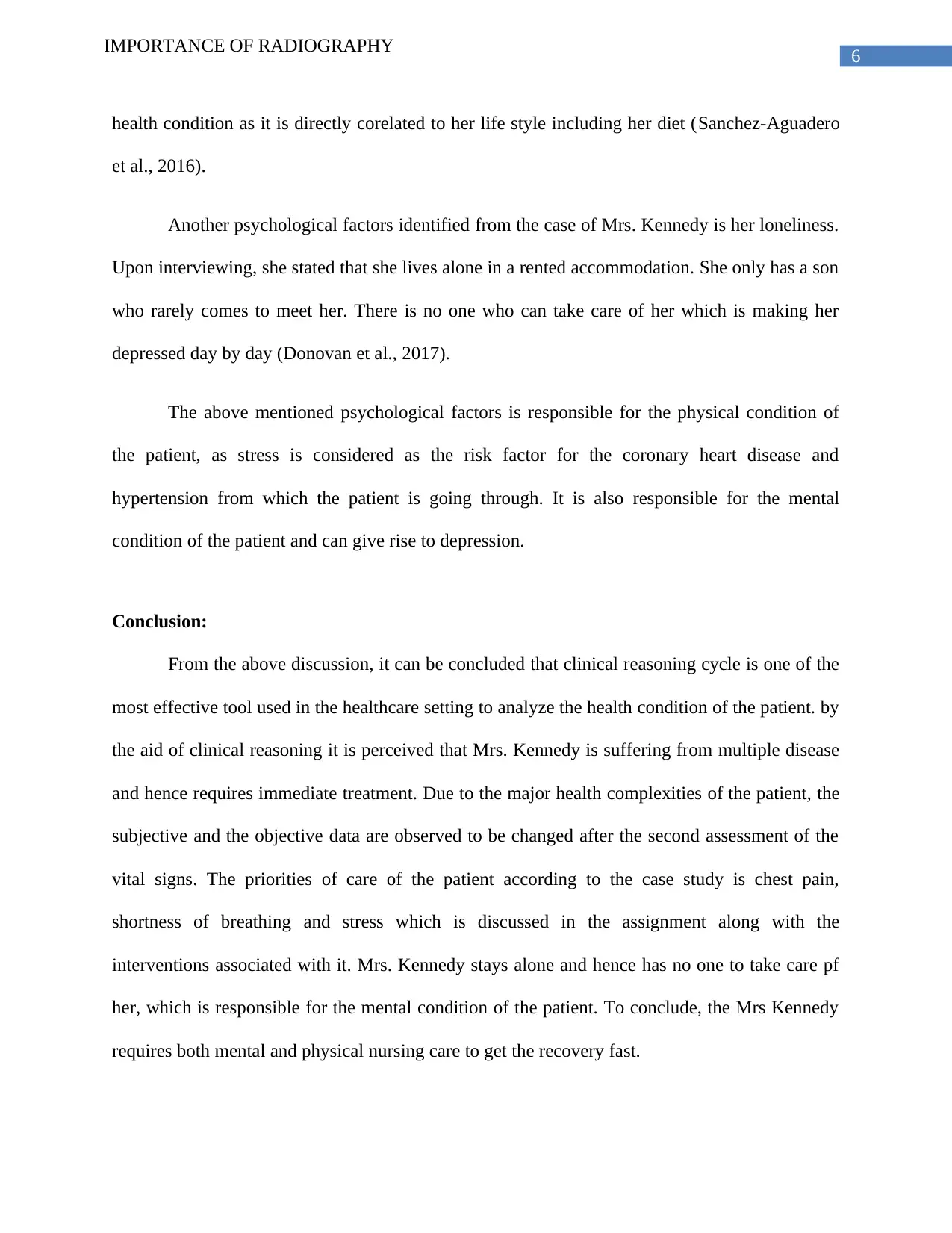
6
IMPORTANCE OF RADIOGRAPHY
health condition as it is directly corelated to her life style including her diet (Sanchez-Aguadero
et al., 2016).
Another psychological factors identified from the case of Mrs. Kennedy is her loneliness.
Upon interviewing, she stated that she lives alone in a rented accommodation. She only has a son
who rarely comes to meet her. There is no one who can take care of her which is making her
depressed day by day (Donovan et al., 2017).
The above mentioned psychological factors is responsible for the physical condition of
the patient, as stress is considered as the risk factor for the coronary heart disease and
hypertension from which the patient is going through. It is also responsible for the mental
condition of the patient and can give rise to depression.
Conclusion:
From the above discussion, it can be concluded that clinical reasoning cycle is one of the
most effective tool used in the healthcare setting to analyze the health condition of the patient. by
the aid of clinical reasoning it is perceived that Mrs. Kennedy is suffering from multiple disease
and hence requires immediate treatment. Due to the major health complexities of the patient, the
subjective and the objective data are observed to be changed after the second assessment of the
vital signs. The priorities of care of the patient according to the case study is chest pain,
shortness of breathing and stress which is discussed in the assignment along with the
interventions associated with it. Mrs. Kennedy stays alone and hence has no one to take care pf
her, which is responsible for the mental condition of the patient. To conclude, the Mrs Kennedy
requires both mental and physical nursing care to get the recovery fast.
IMPORTANCE OF RADIOGRAPHY
health condition as it is directly corelated to her life style including her diet (Sanchez-Aguadero
et al., 2016).
Another psychological factors identified from the case of Mrs. Kennedy is her loneliness.
Upon interviewing, she stated that she lives alone in a rented accommodation. She only has a son
who rarely comes to meet her. There is no one who can take care of her which is making her
depressed day by day (Donovan et al., 2017).
The above mentioned psychological factors is responsible for the physical condition of
the patient, as stress is considered as the risk factor for the coronary heart disease and
hypertension from which the patient is going through. It is also responsible for the mental
condition of the patient and can give rise to depression.
Conclusion:
From the above discussion, it can be concluded that clinical reasoning cycle is one of the
most effective tool used in the healthcare setting to analyze the health condition of the patient. by
the aid of clinical reasoning it is perceived that Mrs. Kennedy is suffering from multiple disease
and hence requires immediate treatment. Due to the major health complexities of the patient, the
subjective and the objective data are observed to be changed after the second assessment of the
vital signs. The priorities of care of the patient according to the case study is chest pain,
shortness of breathing and stress which is discussed in the assignment along with the
interventions associated with it. Mrs. Kennedy stays alone and hence has no one to take care pf
her, which is responsible for the mental condition of the patient. To conclude, the Mrs Kennedy
requires both mental and physical nursing care to get the recovery fast.
Paraphrase This Document
Need a fresh take? Get an instant paraphrase of this document with our AI Paraphraser
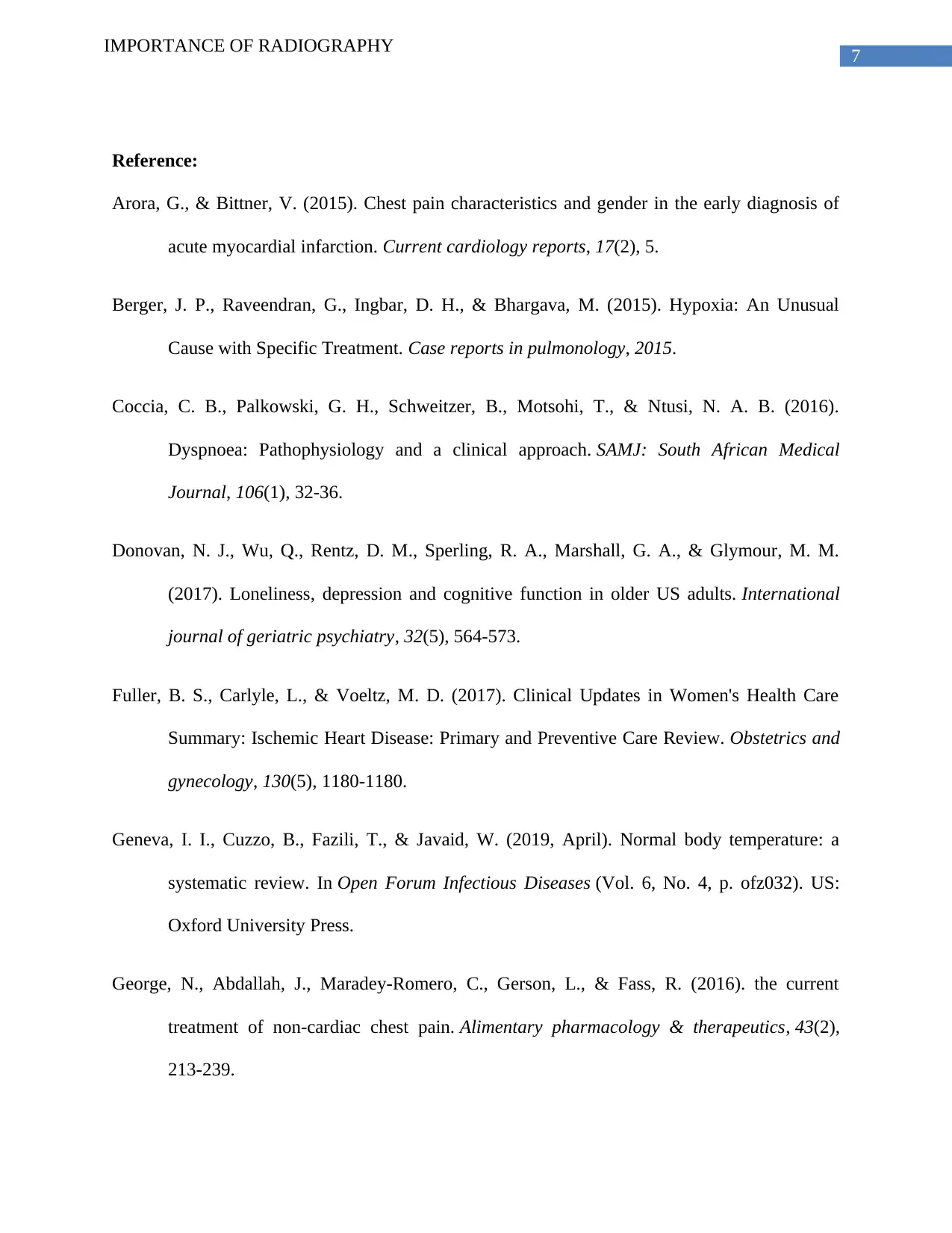
7
IMPORTANCE OF RADIOGRAPHY
Reference:
Arora, G., & Bittner, V. (2015). Chest pain characteristics and gender in the early diagnosis of
acute myocardial infarction. Current cardiology reports, 17(2), 5.
Berger, J. P., Raveendran, G., Ingbar, D. H., & Bhargava, M. (2015). Hypoxia: An Unusual
Cause with Specific Treatment. Case reports in pulmonology, 2015.
Coccia, C. B., Palkowski, G. H., Schweitzer, B., Motsohi, T., & Ntusi, N. A. B. (2016).
Dyspnoea: Pathophysiology and a clinical approach. SAMJ: South African Medical
Journal, 106(1), 32-36.
Donovan, N. J., Wu, Q., Rentz, D. M., Sperling, R. A., Marshall, G. A., & Glymour, M. M.
(2017). Loneliness, depression and cognitive function in older US adults. International
journal of geriatric psychiatry, 32(5), 564-573.
Fuller, B. S., Carlyle, L., & Voeltz, M. D. (2017). Clinical Updates in Women's Health Care
Summary: Ischemic Heart Disease: Primary and Preventive Care Review. Obstetrics and
gynecology, 130(5), 1180-1180.
Geneva, I. I., Cuzzo, B., Fazili, T., & Javaid, W. (2019, April). Normal body temperature: a
systematic review. In Open Forum Infectious Diseases (Vol. 6, No. 4, p. ofz032). US:
Oxford University Press.
George, N., Abdallah, J., Maradey‐Romero, C., Gerson, L., & Fass, R. (2016). the current
treatment of non‐cardiac chest pain. Alimentary pharmacology & therapeutics, 43(2),
213-239.
IMPORTANCE OF RADIOGRAPHY
Reference:
Arora, G., & Bittner, V. (2015). Chest pain characteristics and gender in the early diagnosis of
acute myocardial infarction. Current cardiology reports, 17(2), 5.
Berger, J. P., Raveendran, G., Ingbar, D. H., & Bhargava, M. (2015). Hypoxia: An Unusual
Cause with Specific Treatment. Case reports in pulmonology, 2015.
Coccia, C. B., Palkowski, G. H., Schweitzer, B., Motsohi, T., & Ntusi, N. A. B. (2016).
Dyspnoea: Pathophysiology and a clinical approach. SAMJ: South African Medical
Journal, 106(1), 32-36.
Donovan, N. J., Wu, Q., Rentz, D. M., Sperling, R. A., Marshall, G. A., & Glymour, M. M.
(2017). Loneliness, depression and cognitive function in older US adults. International
journal of geriatric psychiatry, 32(5), 564-573.
Fuller, B. S., Carlyle, L., & Voeltz, M. D. (2017). Clinical Updates in Women's Health Care
Summary: Ischemic Heart Disease: Primary and Preventive Care Review. Obstetrics and
gynecology, 130(5), 1180-1180.
Geneva, I. I., Cuzzo, B., Fazili, T., & Javaid, W. (2019, April). Normal body temperature: a
systematic review. In Open Forum Infectious Diseases (Vol. 6, No. 4, p. ofz032). US:
Oxford University Press.
George, N., Abdallah, J., Maradey‐Romero, C., Gerson, L., & Fass, R. (2016). the current
treatment of non‐cardiac chest pain. Alimentary pharmacology & therapeutics, 43(2),
213-239.
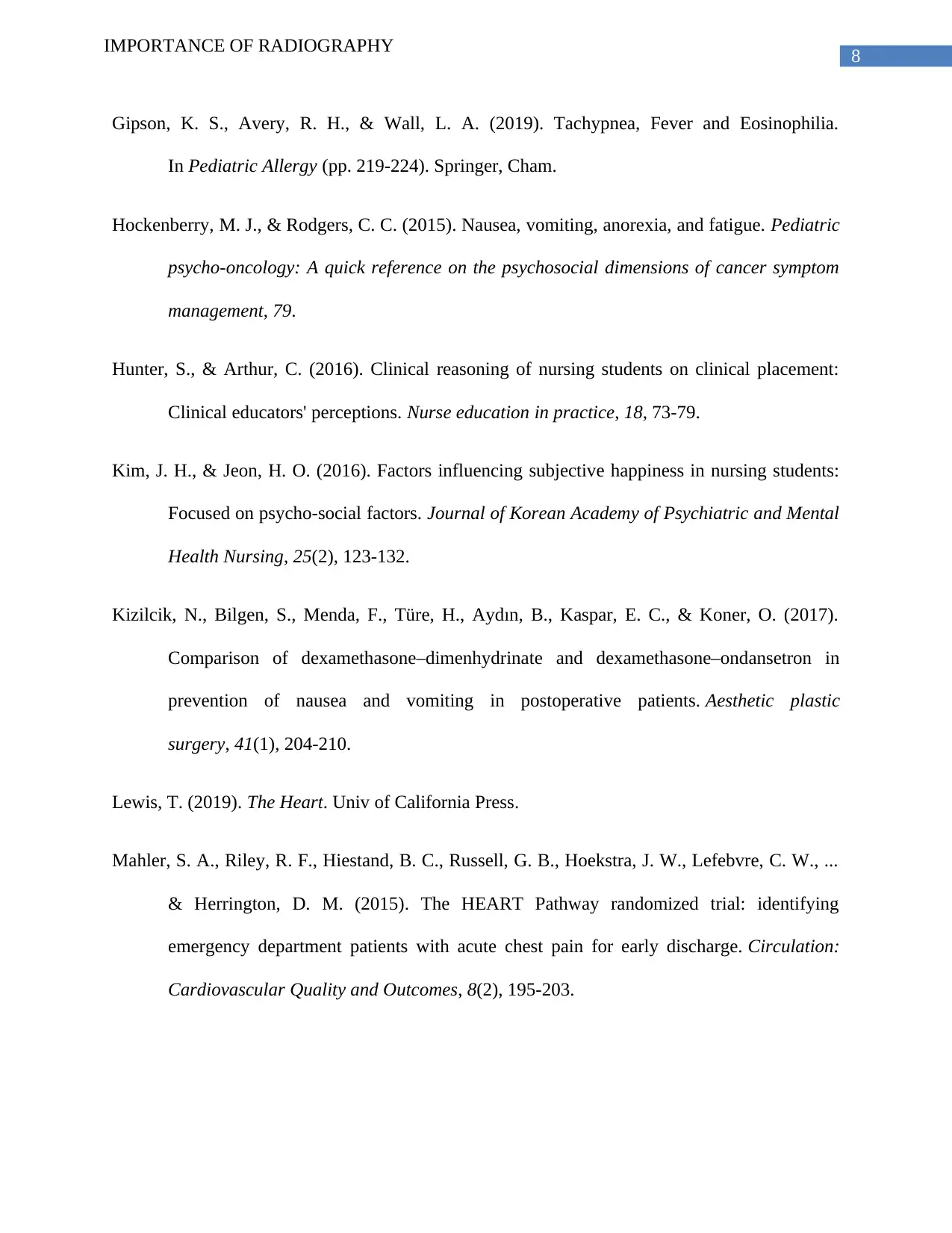
8
IMPORTANCE OF RADIOGRAPHY
Gipson, K. S., Avery, R. H., & Wall, L. A. (2019). Tachypnea, Fever and Eosinophilia.
In Pediatric Allergy (pp. 219-224). Springer, Cham.
Hockenberry, M. J., & Rodgers, C. C. (2015). Nausea, vomiting, anorexia, and fatigue. Pediatric
psycho-oncology: A quick reference on the psychosocial dimensions of cancer symptom
management, 79.
Hunter, S., & Arthur, C. (2016). Clinical reasoning of nursing students on clinical placement:
Clinical educators' perceptions. Nurse education in practice, 18, 73-79.
Kim, J. H., & Jeon, H. O. (2016). Factors influencing subjective happiness in nursing students:
Focused on psycho-social factors. Journal of Korean Academy of Psychiatric and Mental
Health Nursing, 25(2), 123-132.
Kizilcik, N., Bilgen, S., Menda, F., Türe, H., Aydın, B., Kaspar, E. C., & Koner, O. (2017).
Comparison of dexamethasone–dimenhydrinate and dexamethasone–ondansetron in
prevention of nausea and vomiting in postoperative patients. Aesthetic plastic
surgery, 41(1), 204-210.
Lewis, T. (2019). The Heart. Univ of California Press.
Mahler, S. A., Riley, R. F., Hiestand, B. C., Russell, G. B., Hoekstra, J. W., Lefebvre, C. W., ...
& Herrington, D. M. (2015). The HEART Pathway randomized trial: identifying
emergency department patients with acute chest pain for early discharge. Circulation:
Cardiovascular Quality and Outcomes, 8(2), 195-203.
IMPORTANCE OF RADIOGRAPHY
Gipson, K. S., Avery, R. H., & Wall, L. A. (2019). Tachypnea, Fever and Eosinophilia.
In Pediatric Allergy (pp. 219-224). Springer, Cham.
Hockenberry, M. J., & Rodgers, C. C. (2015). Nausea, vomiting, anorexia, and fatigue. Pediatric
psycho-oncology: A quick reference on the psychosocial dimensions of cancer symptom
management, 79.
Hunter, S., & Arthur, C. (2016). Clinical reasoning of nursing students on clinical placement:
Clinical educators' perceptions. Nurse education in practice, 18, 73-79.
Kim, J. H., & Jeon, H. O. (2016). Factors influencing subjective happiness in nursing students:
Focused on psycho-social factors. Journal of Korean Academy of Psychiatric and Mental
Health Nursing, 25(2), 123-132.
Kizilcik, N., Bilgen, S., Menda, F., Türe, H., Aydın, B., Kaspar, E. C., & Koner, O. (2017).
Comparison of dexamethasone–dimenhydrinate and dexamethasone–ondansetron in
prevention of nausea and vomiting in postoperative patients. Aesthetic plastic
surgery, 41(1), 204-210.
Lewis, T. (2019). The Heart. Univ of California Press.
Mahler, S. A., Riley, R. F., Hiestand, B. C., Russell, G. B., Hoekstra, J. W., Lefebvre, C. W., ...
& Herrington, D. M. (2015). The HEART Pathway randomized trial: identifying
emergency department patients with acute chest pain for early discharge. Circulation:
Cardiovascular Quality and Outcomes, 8(2), 195-203.
⊘ This is a preview!⊘
Do you want full access?
Subscribe today to unlock all pages.

Trusted by 1+ million students worldwide
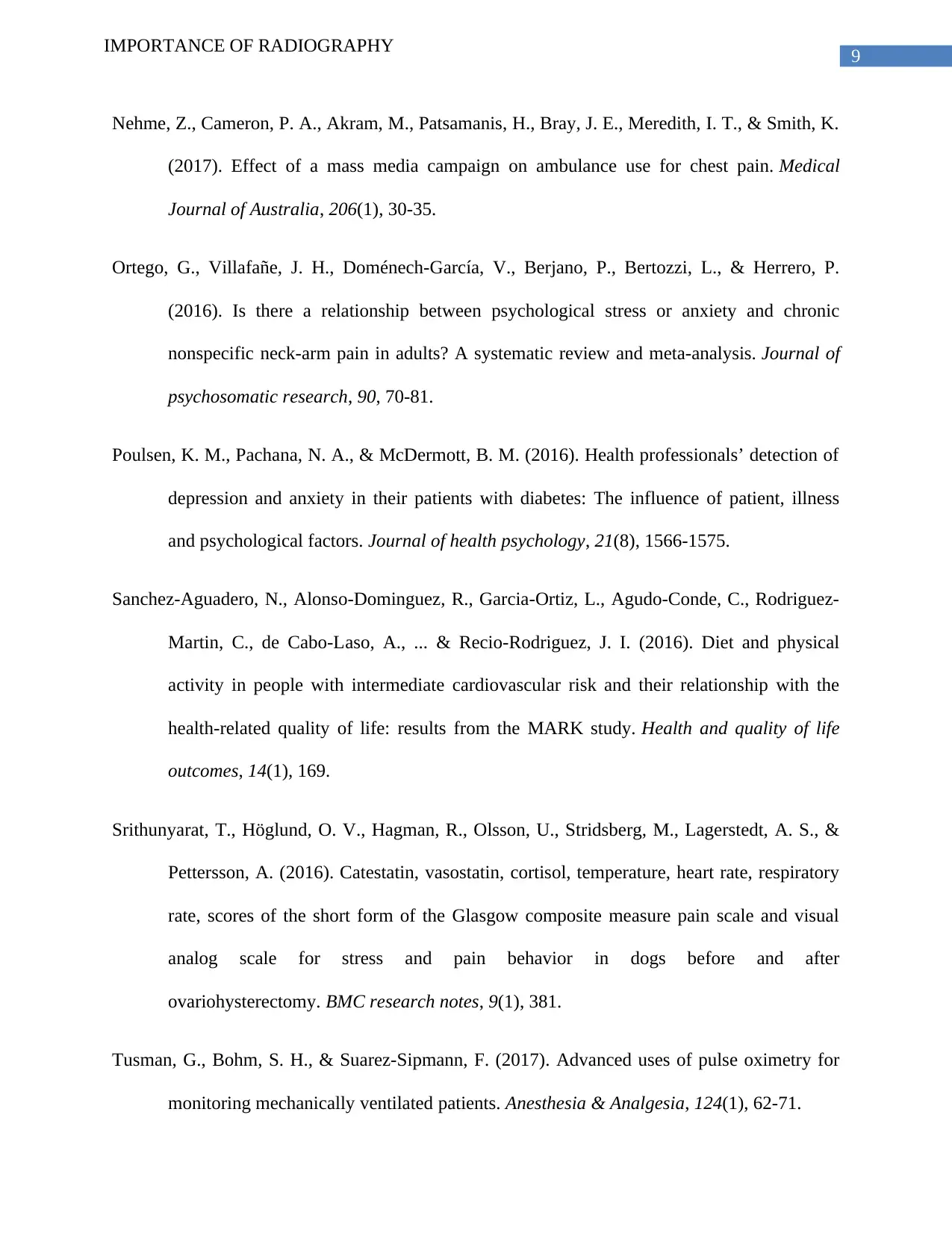
9
IMPORTANCE OF RADIOGRAPHY
Nehme, Z., Cameron, P. A., Akram, M., Patsamanis, H., Bray, J. E., Meredith, I. T., & Smith, K.
(2017). Effect of a mass media campaign on ambulance use for chest pain. Medical
Journal of Australia, 206(1), 30-35.
Ortego, G., Villafañe, J. H., Doménech-García, V., Berjano, P., Bertozzi, L., & Herrero, P.
(2016). Is there a relationship between psychological stress or anxiety and chronic
nonspecific neck-arm pain in adults? A systematic review and meta-analysis. Journal of
psychosomatic research, 90, 70-81.
Poulsen, K. M., Pachana, N. A., & McDermott, B. M. (2016). Health professionals’ detection of
depression and anxiety in their patients with diabetes: The influence of patient, illness
and psychological factors. Journal of health psychology, 21(8), 1566-1575.
Sanchez-Aguadero, N., Alonso-Dominguez, R., Garcia-Ortiz, L., Agudo-Conde, C., Rodriguez-
Martin, C., de Cabo-Laso, A., ... & Recio-Rodriguez, J. I. (2016). Diet and physical
activity in people with intermediate cardiovascular risk and their relationship with the
health-related quality of life: results from the MARK study. Health and quality of life
outcomes, 14(1), 169.
Srithunyarat, T., Höglund, O. V., Hagman, R., Olsson, U., Stridsberg, M., Lagerstedt, A. S., &
Pettersson, A. (2016). Catestatin, vasostatin, cortisol, temperature, heart rate, respiratory
rate, scores of the short form of the Glasgow composite measure pain scale and visual
analog scale for stress and pain behavior in dogs before and after
ovariohysterectomy. BMC research notes, 9(1), 381.
Tusman, G., Bohm, S. H., & Suarez-Sipmann, F. (2017). Advanced uses of pulse oximetry for
monitoring mechanically ventilated patients. Anesthesia & Analgesia, 124(1), 62-71.
IMPORTANCE OF RADIOGRAPHY
Nehme, Z., Cameron, P. A., Akram, M., Patsamanis, H., Bray, J. E., Meredith, I. T., & Smith, K.
(2017). Effect of a mass media campaign on ambulance use for chest pain. Medical
Journal of Australia, 206(1), 30-35.
Ortego, G., Villafañe, J. H., Doménech-García, V., Berjano, P., Bertozzi, L., & Herrero, P.
(2016). Is there a relationship between psychological stress or anxiety and chronic
nonspecific neck-arm pain in adults? A systematic review and meta-analysis. Journal of
psychosomatic research, 90, 70-81.
Poulsen, K. M., Pachana, N. A., & McDermott, B. M. (2016). Health professionals’ detection of
depression and anxiety in their patients with diabetes: The influence of patient, illness
and psychological factors. Journal of health psychology, 21(8), 1566-1575.
Sanchez-Aguadero, N., Alonso-Dominguez, R., Garcia-Ortiz, L., Agudo-Conde, C., Rodriguez-
Martin, C., de Cabo-Laso, A., ... & Recio-Rodriguez, J. I. (2016). Diet and physical
activity in people with intermediate cardiovascular risk and their relationship with the
health-related quality of life: results from the MARK study. Health and quality of life
outcomes, 14(1), 169.
Srithunyarat, T., Höglund, O. V., Hagman, R., Olsson, U., Stridsberg, M., Lagerstedt, A. S., &
Pettersson, A. (2016). Catestatin, vasostatin, cortisol, temperature, heart rate, respiratory
rate, scores of the short form of the Glasgow composite measure pain scale and visual
analog scale for stress and pain behavior in dogs before and after
ovariohysterectomy. BMC research notes, 9(1), 381.
Tusman, G., Bohm, S. H., & Suarez-Sipmann, F. (2017). Advanced uses of pulse oximetry for
monitoring mechanically ventilated patients. Anesthesia & Analgesia, 124(1), 62-71.
Paraphrase This Document
Need a fresh take? Get an instant paraphrase of this document with our AI Paraphraser

10
IMPORTANCE OF RADIOGRAPHY
Zencir, G., & Eser, I. (2016). Effects of Cold Therapy on Pain and Breathing Exercises Among
Median Sternotomy Patients. Pain Management Nursing, 17(6), 401-410.
IMPORTANCE OF RADIOGRAPHY
Zencir, G., & Eser, I. (2016). Effects of Cold Therapy on Pain and Breathing Exercises Among
Median Sternotomy Patients. Pain Management Nursing, 17(6), 401-410.
1 out of 11
Related Documents
Your All-in-One AI-Powered Toolkit for Academic Success.
+13062052269
info@desklib.com
Available 24*7 on WhatsApp / Email
![[object Object]](/_next/static/media/star-bottom.7253800d.svg)
Unlock your academic potential
Copyright © 2020–2025 A2Z Services. All Rights Reserved. Developed and managed by ZUCOL.


